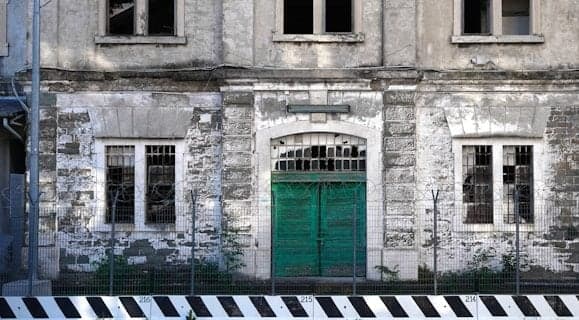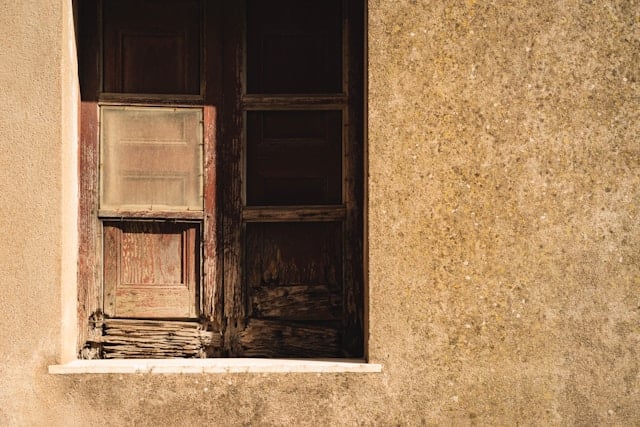Why there are so many derelict houses in Italy - and no-one seems to care

From hilltop towns to seafront promenades, many parts of Italy are blighted by dilapidated buildings left to rot under the sun. So why don't local authorities tear them down and sell off the land? Reporter Silvia Marchetti explains.
As many remote Italian towns are desperate to sell off old abandoned buildings - some do so successfully, others struggle - foreigners are often baffled by the fact that there are still so many dilapidated properties in Italy.
In almost any village there are houses in need of repair, covered in moss and vegetation, with broken windows and doors, apparently without owners.
The main reason why there are so many of these forsaken homes is because the original owners have long migrated to other countries in search of a brighter future, or fled following natural calamities such as earthquakes, volcanic eruptions or landslides, leaving behind empty dwellings.
These empty buildings can sit rotting in the sun for decades, if not centuries. No one seems interested in selling them off cheaply, likely because the heirs are nowhere to be found or can’t be bothered to deal with major renovation work or labyrinthine bureaucracy.
READ ALSO: Five pitfalls to watch out for when buying an old house in Italy
Local councils and mayors, who might dream of putting these buildings up for sale for a song or even a symbolic one euro to attract new buyers and breathe new life into dying communities, have their hands tied, in most cases forever.
Authorities can seize these abandoned properties and place them on the market only if the buildings are a threat to ‘public safety and order’, like if there is the danger that parts of the building may crumble and kill passers-by or damage nearby properties or roads.
There is currently no law in Italy that allows town halls to seize these dilapidated buildings after a set number of years, and this is frustrating for mayors eager to give the old town centres a makeover, making them more appealing to tourists and buyers.
READ ALSO: Why Italians aren’t snatching up their country’s one-euro homes
I was recently talking to a friend of mine, who was deputy mayor in a town in Basilicata, and he complained how the only instances in which he ever stepped in to seize a property were when it had already crumbled to the ground.
There is one exception: that’s when local authorities are the direct and sole owners of a building. There are specific laws approved by governments in the past granting towns struck by natural calamities to seize the buildings for public safety.

Photo by Ehud Neuhaus on Unsplash
In Campania, where a terrible earthquake hit the Irsina area in 1980 sending locals running for their lives, many towns now have ghost districts which have passed into the hands of councils. Many villages there, like Zungoli and Bisaccia, have in fact since been able to sell dozens of old homes for one euro or a little more.
The process was quick here because the councils owned the properties. Sambuca in Sicily, struck by the 1968 Belice Valley quake, owns dozens of abandoned buildings in the old town centre, and it has already successfully sold two batches of cheap empty homes, triggering a property stampede.
Another major problem in Italy is ‘abusivismo’ - illegal constructions that across time have turned into what Italians call eco-monsters, buildings that mar the environment and beauty of places.
READ ALSO: 'Italy's one-euro homes cost a lot more than one euro - but can be worth it'
These can be abandoned concrete buildings such as old restaurants, beach clubs, sports centres, and shops built illegally, for instance along a lungomare seaside promenade back in the 1970s-1980s, that ruin the skyline and are ‘un pugno nell’occhio’ (an eyesore; literally 'a punch in the eye').
Visitors from abroad may well wonder why these ugly, abandoned buildings aren't torn down and the land sold to developers. But they are normally only seized and demolished by local authorities if there are plans to redevelop the area with new public facilities, like playgrounds, public gardens or sports centres. Otherwise no-one cares.
The trouble is, there is no political discussion of allowing mayors to seize derelict buildings and old illegal constructions after a certain number of years, even in the absence of urban regeneration projects and immediate safety risks.
I think the government should take the issue more seriously, particularly if it wants to support the repopulation of Italy's old villages by allowing interested buyers to give a new life to forgotten and neglected neighbourhoods.
Comments (2)
See Also
As many remote Italian towns are desperate to sell off old abandoned buildings - some do so successfully, others struggle - foreigners are often baffled by the fact that there are still so many dilapidated properties in Italy.
In almost any village there are houses in need of repair, covered in moss and vegetation, with broken windows and doors, apparently without owners.
The main reason why there are so many of these forsaken homes is because the original owners have long migrated to other countries in search of a brighter future, or fled following natural calamities such as earthquakes, volcanic eruptions or landslides, leaving behind empty dwellings.
These empty buildings can sit rotting in the sun for decades, if not centuries. No one seems interested in selling them off cheaply, likely because the heirs are nowhere to be found or can’t be bothered to deal with major renovation work or labyrinthine bureaucracy.
READ ALSO: Five pitfalls to watch out for when buying an old house in Italy
Local councils and mayors, who might dream of putting these buildings up for sale for a song or even a symbolic one euro to attract new buyers and breathe new life into dying communities, have their hands tied, in most cases forever.
Authorities can seize these abandoned properties and place them on the market only if the buildings are a threat to ‘public safety and order’, like if there is the danger that parts of the building may crumble and kill passers-by or damage nearby properties or roads.
There is currently no law in Italy that allows town halls to seize these dilapidated buildings after a set number of years, and this is frustrating for mayors eager to give the old town centres a makeover, making them more appealing to tourists and buyers.
READ ALSO: Why Italians aren’t snatching up their country’s one-euro homes
I was recently talking to a friend of mine, who was deputy mayor in a town in Basilicata, and he complained how the only instances in which he ever stepped in to seize a property were when it had already crumbled to the ground.
There is one exception: that’s when local authorities are the direct and sole owners of a building. There are specific laws approved by governments in the past granting towns struck by natural calamities to seize the buildings for public safety.

In Campania, where a terrible earthquake hit the Irsina area in 1980 sending locals running for their lives, many towns now have ghost districts which have passed into the hands of councils. Many villages there, like Zungoli and Bisaccia, have in fact since been able to sell dozens of old homes for one euro or a little more.
The process was quick here because the councils owned the properties. Sambuca in Sicily, struck by the 1968 Belice Valley quake, owns dozens of abandoned buildings in the old town centre, and it has already successfully sold two batches of cheap empty homes, triggering a property stampede.
Another major problem in Italy is ‘abusivismo’ - illegal constructions that across time have turned into what Italians call eco-monsters, buildings that mar the environment and beauty of places.
READ ALSO: 'Italy's one-euro homes cost a lot more than one euro - but can be worth it'
These can be abandoned concrete buildings such as old restaurants, beach clubs, sports centres, and shops built illegally, for instance along a lungomare seaside promenade back in the 1970s-1980s, that ruin the skyline and are ‘un pugno nell’occhio’ (an eyesore; literally 'a punch in the eye').
Visitors from abroad may well wonder why these ugly, abandoned buildings aren't torn down and the land sold to developers. But they are normally only seized and demolished by local authorities if there are plans to redevelop the area with new public facilities, like playgrounds, public gardens or sports centres. Otherwise no-one cares.
The trouble is, there is no political discussion of allowing mayors to seize derelict buildings and old illegal constructions after a certain number of years, even in the absence of urban regeneration projects and immediate safety risks.
I think the government should take the issue more seriously, particularly if it wants to support the repopulation of Italy's old villages by allowing interested buyers to give a new life to forgotten and neglected neighbourhoods.
Join the conversation in our comments section below. Share your own views and experience and if you have a question or suggestion for our journalists then email us at [email protected].
Please keep comments civil, constructive and on topic – and make sure to read our terms of use before getting involved.
Please log in here to leave a comment.